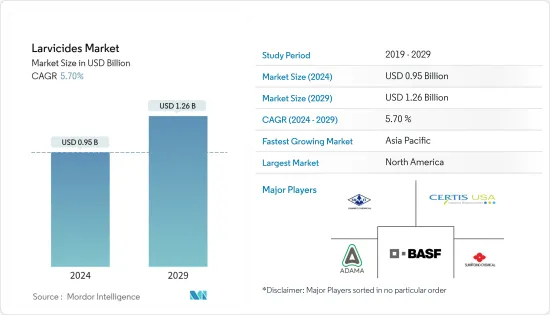
유충 살충제 시장 규모는 2024년 9억 5,000만 달러로 추정되고, 2029년까지 12억 6,000만 달러에 이를 것으로 예측되며, 예측 기간 동안 복합 연간 성장률(CAGR) 5.70%로 성장할 전망입니다.

신형 코로나바이러스 감염(COVID-19)의 갑작스런 발생으로 여러 국가에서 엄격한 락다운 규제가 도입되어 유충 살충제의 수출입 활동에 혼란이 생겼습니다. 지방자치단체의 부문과 모기대책 지구는 유행 중에는 대규모 모기 대책 활동을 주도합니다. 활동 중 하나는 유충 살충제를 살포하는 것입니다. 인가된 모기 구제 전문가들은 영향을 받는 지역의 규모에 따라 배낭 분무기, 트럭 및 비행기를 사용하여 환경보호청(EPA)에 등록된 유충 살충제를 살포합니다.
WHO에 따르면 개발도상국에 사는 인구의 40%가 말라리아 등 심각한 질병에 걸리는 위험에 노출되어 있다고 합니다. 말라리아는 암컷 하마다라카가 매개하는 기생충에 의해 야기되는 생명을 위협하는 질병 중 하나입니다. 예를 들어, 2017년에는 87개국에서 2억 1,900만 명의 말라리아 환자가 발생했으며, 말라리아 대책을 위한 총 자금은 31억 달러로 추정되었습니다. 열대 국가의 국가 기부금은 9억 달러에 이르렀으며 총 자금의 28%를 차지했습니다. 질병 발생 건수 증가, 매개 동물 유행, 해충 공격 증가는 세계 유충 구제 시장을 견인하는 주요 요인의 일부입니다. 지역 중에서도 아시아태평양은 기후 변화의 영향으로 유충 구제 시장에서 큰 점유율을 차지하고 있어 도시 해충에 의한 공중위생에 대한 위협이 되고 있습니다.
모기가 중재하는 질병은 남미와 같은 대부분의 국가에서 치명적인 피해를 초래합니다. 베네수엘라는 2019년 말라리아에 의한 126명의 사망을 보고했습니다. 말라리아, 치쿤그니아 열, 뎅기열 등 치명적인 질병은 유충 살충제로 치료할 수 있습니다. 예를 들어, 지카바이러스와 같은 질병 발생으로 인해 유럽에서는 모기 집단이 확산되기 쉬워졌습니다. 사하라 이남의 아프리카, 중동, 라틴아메리카, 아시아 및 유럽의 일부 지역은 말라리아의 영향을받는 지역입니다. 따라서 뎅기열과 말라리아 증례 증가에 대한 우려는 대상 지역의 유충 구제 시장에 기회를 가져옵니다. 게다가 개발도상분야에 대한 정부지출과 다국적기업의 참여가 유충구제 시장을 추진하고 있습니다.
벡터 매개 질환의 확산, 전염병, 기후 변화, 해충 수 증가, 생태학적 지속가능성 등의 요인이 시장 성장을 가속하고 있습니다.
북미는 이 지역에 많은 다국적 기업들이 존재하기 때문에 최대 소비국으로 추정됩니다. 미국과 캐나다 시장은 효과적인 감시 프로그램과 중재 동물 제거 프로그램 덕분에 거대합니다. 2017년에는 북미가 가장 큰 점유율을 차지한 다음 유럽이 계속되었습니다. 아시아태평양은 모기가 중재하는 질병의 확산으로 최고의 복합 연간 성장률(CAGR)을 나타낼 것으로 예상됩니다. 고도의 도시화와 해충에 대한 국민의 불관용 증가로 미래에 유충 구제 시장이 가속될 것으로 예상됩니다.
액체 유충 살충제 제품은 분무기를 사용하여 물에 직접 적용됩니다. 정제, 펠릿, 과립, 연탄과 같은 애벌레 구제 제제도 모기 구제자에 의해 번식 지역에 널리 사용됩니다. 미국에서는 환경보호청(미국 EPA)이 세 가지 주요 유형의 유충 방제제, 즉 미생물 유충 살충제, 곤충 성장 억제제 및 화학 살충제(주로 테메포스)를 등록했습니다. Bacillus thuringiensis israelensis(Bti)는 물에 존재하는 모기 유충을 효과적으로 죽일 수있는 천연 토양 박테리아입니다. Aquabac, Teknar, Baltimore 및 Vectobac은 상업용 Bti 균주의 일부입니다.
애벌레 구제 시장은 매우 세분화되어 있습니다. 대기업은 합작 투자, 신제품 출시, 파트너십, 계약, 확장, 합병 및 인수 등 다양한 전략을 사용하여 시장에서 발자국을 확대하고 있습니다.
The Larvicides Market size is estimated at USD 0.95 billion in 2024, and is expected to reach USD 1.26 billion by 2029, growing at a CAGR of 5.70% during the forecast period (2024-2029).

The sudden outbreak of COVID-19 led to the implementation of stringent lockdown regulations across several nations, resulting in disruptions in the import and export activities of larvicides. Local government departments and mosquito control districts lead large-scale mosquito control activities during an outbreak. One activity is to apply larvicides. Licensed mosquito control professionals apply Environmental Protection Agency (EPA)-registered larvicides using backpack sprayers, trucks, or airplanes, depending on the size of the area being affected.
According to the WHO, 40% of the population living in underdeveloped countries is at risk of serious diseases, such as malaria, which is one of the life-threatening diseases caused by parasites transmitted by female anopheles mosquitoes. For instance, in 2017, there were an estimated 219 million malaria cases in 87 countries, and the total funding for malaria control was estimated at USD 3.1 billion. State contributions from tropical countries contributed to USD 900 million, accounting for 28% of total funding. An increasing number of disease outbreaks, vector-based epidemics, and growing pest attacks are some of the major factors driving the larvicides market globally. Among the regions, Asia-Pacific holds the major share in the larvicides market due to climate change, which poses a threat to public health caused by urban pests.
Mosquito-borne diseases have become devastating in most countries, such as South America. Venezuela reported 126 deaths in 2019 due to malaria. Deadly diseases such as malaria, chikungunya, and dengue can be managed by larvicide. For example, the disease outbreaks such as the Zika virus have made the European region more susceptible to the spread of mosquito populations. Sub-Saharan Africa, the Middle-East, Latin America, Asia, and several parts of Europe are malaria-affected regions. Thus, the concerns about increasing dengue and malaria cases create an opportunity for the larvicides market in the target region. Additionally, government spending in the developing sector and the involvement of multinational companies drive the larvicides market.
Factors such as the increasing prevalence of vector-borne diseases, epidemics, climatic changes, rising pest population, and ecological sustainability are driving the market's growth.
North America is estimated as the largest consumer due to the presence of many multinational companies in the region. The US and Canadian markets are huge due to effective surveillance and vector control programs. North America accounted for the largest share in 2017, followed by Europe. Asia-Pacific is projected to record the highest CAGR due to the spread of mosquito-borne diseases. High urbanization and rising public intolerance of pests are anticipated to fuel the larvicides market in the future.
Liquid larvicide products are applied directly to water using sprayers. Tablet, pellet, granular, and briquet formulations of larvicides are also widely applied by mosquito controllers to breeding areas. In the United States, the Environment Protection Agency (US EPA) registered three major types of larval control agents, i.e., microbial larvicides, insect growth inhibitors, and chemical insecticides (mainly temephos). Bacillus thuringiensis israelensis (Bti) is a naturally occurring soil bacterium that can effectively kill mosquito larvae present in water. Aquabac, Teknar, Baltimore, and Vectobac are some of the commercially available Bti strains.
The larvicides market is highly fragmented. The major players use various strategies such as joint ventures, new product launches, partnerships, agreements, expansions, and mergers and acquisitions to increase their footprint in the market.